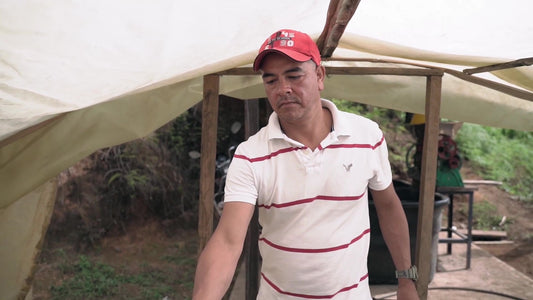Exploring Coffee Varietals: Origins, Growth, and Flavour Profiles
You’ve just bought a new pack of coffee from your favourite independent roaster and on the label it lists a load of coffee varietals names. Why does the roaster put these here? Do they make any difference to the flavour of the coffee? Too embarrassed to ask the barista in case it makes you look uninformed? Don’t worry, hopefully we can help you out with a few basics so next time you can confidently choose the right coffee for you.
Coffee, a drink savoured by millions around the globe, has a story as rich and complex as its flavour. As you sip your morning cup, have you ever pondered where those beans came from, or why they taste the way they do? This post delves into the fascinating world of coffee varietals, their origins, growing regions, and how they impact the final cup's flavour and quality. By understanding these aspects, you can appreciate the journey your coffee has taken from a seed to your cup.

Understanding Coffee Varietals
Definition of Coffee Varietals
Coffee varietals are specific subspecies or cultivars of coffee plants. Each varietal has unique genetic characteristics that influence the plant's growth and the flavour profile of its beans. It's essential to differentiate between varietals, species, and blends. While a varietal refers to a specific genetic lineage within a species, a blend is a mixture of beans from different varietals or regions.
Importance of Coffee Varietals
The varietal of a coffee bean plays a critical role in determining its flavour, aroma, and overall quality. Genetics influence aspects such as sweetness, acidity, body, and even the resilience of the plant to pests and diseases. Coffee farmers select varietals not only for their taste but also for their adaptability to specific growing conditions.
Major Coffee Species
Arabica (Coffea arabica)
Arabica coffee, accounting for about 60% of the world's coffee production, is known for its superior flavour and aromatic qualities. It grows best in high altitudes and requires specific climate conditions, such as cooler temperatures and ample rainfall. Arabica beans tend to have a wider flavour range, including notes of fruit, sugar, and floral elements. Some common Arabica varietals include Typica, Bourbon, SL28, SL34, Geisha, and Caturra.
Robusta (Coffea canephora)
Robusta coffee, comprising about 40% of global production, is more robust (hence the name) and resilient than Arabica. It can thrive in lower altitudes and higher temperatures, making it easier to cultivate in diverse environments. Robusta beans have a stronger, often more bitter flavour, with higher caffeine content and lower acidity. Common varietals include Conilon and Kouillou.
Notable Coffee Varietals
Arabica Varietals

Typica
Origin and History: Typica is one of the oldest coffee varietals, originating from the coffee forests of Ethiopia and spreading to Yemen, then to the rest of the world.
Growing Regions: It is widely cultivated in Latin America and Asia.
Flavour Profile: Typica beans are known for their sweetness, complexity, and well-balanced acidity. They often exhibit delicate floral and fruity notes.
Bourbon
Origin and History: Bourbon originated from a French island in the Indian Ocean (now Réunion) and was later introduced to Latin America and Africa.
Growing Regions: Predominantly grown in Latin America and East Africa.
Flavour Profile: Bourbon beans are prized for their sweetness, fruitiness, and balanced acidity. They typically have a fuller body and rich chocolate or nutty undertones.
Geisha
Origin and History: Originally from Ethiopia, Geisha gained prominence in Panama due to its extraordinary flavour profile.
Growing Regions: Central America, particularly Panama and Costa Rica.
Flavour Profile: Geisha is celebrated for its floral and jasmine-like aromas, along with vibrant acidity and complex fruity notes like bergamot and tropical fruits.
SL28 and SL34
Origin and History: Developed in Kenya by Scott Agricultural Laboratories in the 1930s, these varietals are known for their drought resistance and high-quality beans.
Growing Regions: East Africa, especially Kenya.
Flavour Profile: SL28 and SL34 beans are noted for their bright acidity, citrusy flavours, and berry-like sweetness, often described as having a "winey" quality.
Caturra
Origin and History: A mutation of Bourbon, Caturra was discovered in Brazil in the 1930s.
Growing Regions: Commonly grown in Latin America.
Flavour Profile: Caturra beans are known for their bright acidity, citric notes, and a nutty undertone. They tend to have a lighter body compared to other varietals.
Pacamara
Origin and History: A hybrid of the Pacas and Maragogipe varietals, Pacamara was developed in El Salvador in the 1950s.
Growing Regions: Primarily grown in Central America.
Flavour Profile: Pacamara beans offer a complex flavour profile, with bright acidity, a creamy body, and notes of chocolate, fruit, and florals.
Robusta Varietals
Conilon and Kouillou
Origin and History: These varietals are indigenous to West Africa and have been adapted for cultivation in various parts of the world.
Growing Regions: West Africa and Southeast Asia.
Flavour Profile: Robusta beans, including Conilon and Kouillou, are typically earthy, nutty, and have a more bitter taste. They also contain higher caffeine levels, which contribute to their strong, bold flavours.
How Coffee Varietals Were Transported Across the World
Early Coffee Cultivation
Coffee cultivation began in Ethiopia, where the coffee plant is native. From Ethiopia, coffee spread to Yemen, where it became a cultivated crop. Yemeni traders then transported coffee to the Arabian Peninsula, establishing the coffee trade in the Middle East.
European Influence
In the 17th century, coffee reached Europe, where it quickly gained popularity. Coffee houses became social hubs in cities like London, Paris, and Vienna. European colonial powers saw the potential in coffee cultivation and began transporting coffee plants to their colonies.
Key Historical Movements
Dutch Transportation to Asia
The Dutch were instrumental in spreading coffee cultivation to Asia. In the 1600s, they brought coffee plants from Yemen to Java, part of modern-day Indonesia. Java quickly became a significant coffee-producing region, and the term "Java" is still synonymous with coffee today.
French Introduction to the Caribbean and South America
The French introduced coffee to the Caribbean in the early 1700s. From there, coffee cultivation spread to Central and South America. The island of Martinique became a key point for the distribution of coffee plants to other parts of the Americas.
British Influence in India and East Africa
The British also played a crucial role in the spread of coffee. They introduced coffee to India in the 1600s, and by the 1800s, coffee was being cultivated in British East Africa (modern-day Kenya and Tanzania).
Portuguese Expansion to Brazil
The Portuguese were responsible for bringing coffee to Brazil in the early 18th century. Brazil eventually became the world's largest coffee producer, thanks to its ideal growing conditions and the vast scale of its plantations.
Modern-Day Spread
Today, coffee continues to spread and evolve. Efforts to create new hybrids and cultivate coffee in non-traditional regions are ongoing. Researchers and farmers work together to adapt coffee plants to changing climates and to explore new flavour profiles.
Growing Regions and Their Impact
Geographical Influence on Coffee Varietals
The geographical location where coffee is grown significantly influences its flavour profile. Factors such as climate, altitude, and soil composition all play crucial roles.
Latin America
Latin America is one of the most significant coffee-growing regions, with countries like Brazil, Colombia, and Guatemala leading production.
Brazil: Known for its vast coffee plantations, Brazil produces a wide range of coffee varietals. Brazilian coffees are often characterized by a nutty, chocolatey flavour with low acidity.
Colombia: Colombian coffee is renowned for its balanced flavour profile, bright acidity, and medium body. The country's diverse microclimates allow for a wide variety of flavour notes.
Guatemala: Guatemalan coffee is known for its rich, full-bodied flavour with a distinct chocolate and spice profile. High-altitude regions like Antigua produce some of the finest beans.
Africa
Africa is the birthplace of coffee and continues to produce some of the world's most distinctive and sought-after coffees.
Ethiopia: Ethiopian coffee is famous for its complex, fruity, and floral flavours. Regions like Yirgacheffe and Sidamo are particularly renowned.
Kenya: Kenyan coffee is known for its bright acidity, wine-like flavour, and bold, fruity notes. The SL28 and SL34 varietals are particularly celebrated.
Asia
Asia, particularly Southeast Asia, is a major coffee-growing region, with countries like Vietnam and Indonesia leading production.
Vietnam: As the world's largest producer of Robusta coffee, Vietnam's beans are typically bold and earthy with a strong, bitter flavour.
Indonesia: Indonesian coffee, especially from Sumatra and Java, is known for its heavy body, low acidity, and complex, earthy flavours.
Central America
Central America is home to many high-quality coffee-producing countries, each offering unique flavour profiles.
Costa Rica: Known for its high-quality Arabica coffee, Costa Rican beans are often bright and acidic with fruity and floral notes.
El Salvador: El Salvador produces exceptional coffee with a balanced profile, featuring sweet and nutty flavours with a smooth body.
Honduras: Honduran coffee has gained recognition for its rich, full-bodied flavours and vibrant acidity, often with chocolate and caramel notes.
From Farm to Cup: The Journey of Coffee
Cultivation Practices
Coffee cultivation involves a combination of traditional and modern farming methods. Traditional methods often involve shade-grown coffee, which promotes biodiversity and provides a habitat for wildlife. Modern methods focus on improving yield and disease resistance through scientific research and technology.
Sustainability is becoming increasingly important in coffee farming. Practices such as organic farming, fair trade certification, and direct trade relationships help ensure that coffee production is environmentally friendly and socially responsible.
Processing Methods
Once coffee cherries are harvested, they undergo processing to remove the beans from the fruit. The processing method significantly impacts the final flavour of the coffee.
Washed (Wet) Process: In this method, the beans are removed from the cherries and then fermented to remove the mucilage. Washed coffees often have a clean, bright flavour with pronounced acidity.
Natural (Dry) Process: The cherries are dried whole, allowing the beans to absorb flavours from the fruit. Natural processed coffees are often fruity and sweet, with a heavier body.
Honey Process: A hybrid method where the beans are partially dried with some mucilage left intact. Honey processed coffees have a balanced flavour profile, combining the brightness of washed coffees with the sweetness of natural coffees.

Roasting and Brewing
After processing, coffee beans are roasted to bring out their flavour. Roasting is an art and science, with different roast levels (light, medium, dark) affecting the beans' flavour profile. Light roasts tend to preserve the beans' original characteristics, while dark roasts bring out deeper, more robust flavours.
Brewing methods also play a crucial role in the final taste of coffee. Popular methods include:
Drip Coffee: A straightforward and popular brewing method using a drip coffee maker. Produces a clean, consistent cup.
French Press: A full-immersion brewing method that results in a rich, full-bodied coffee with a thicker texture.
Espresso: A concentrated brewing method that produces a small, intense shot of coffee. Forms the base for many specialty drinks like lattes and cappuccinos.
Pour-Over: A manual brewing method that allows for precise control over the brewing process, resulting in a clean, bright cup.

Tasting Notes and Flavour Profiles
How to Taste Coffee
Tasting coffee, also known as cupping, is a method used to evaluate the flavour profile of different coffees. The process involves smelling the ground coffee, brewing it, and then slurping the coffee to aerate it and spread it across the palate.
Recognizing Flavors, Aromas, and Acidity
When tasting coffee, look for specific flavour notes (such as fruit, chocolate, or spice), aromas (like floral or nutty scents), and the level of acidity. Acidity in coffee is not the same as sourness; it's more about the brightness and liveliness of the flavour.
Comparing Varietals
Comparing varietals side by side can help you understand their unique characteristics. For example, tasting a Typica alongside a Bourbon can highlight Typica's complexity and Bourbon's sweetness. Similarly, comparing a Geisha with an SL28 can showcase Geisha's floral notes and SL28's bright acidity.
The Future of Coffee Varietals
Innovation in Coffee Breeding
Researchers and coffee breeders are continually working on developing new hybrids and experimental varietals. These efforts aim to improve disease resistance, yield, and flavour. Hybrid varietals like the Timor Hybrid (a cross between Arabica and Robusta) show promise for their resilience and unique flavour profiles.
Challenges and Opportunities
Climate change poses a significant threat to coffee cultivation, affecting traditional growing regions. Rising temperatures, changing rainfall patterns, and increased pest and disease pressure necessitate adaptive strategies. Efforts are underway to cultivate coffee at higher altitudes and in non-traditional regions to combat these challenges.
Sustainability is also a key focus. Coffee farmers and researchers are exploring ways to reduce the environmental impact of coffee production, such as using renewable energy sources, conserving water, and promoting biodiversity.
The Role of Technology
Technology is playing an increasingly important role in coffee cultivation and processing. Advanced techniques in breeding, such as genetic mapping and marker-assisted selection, are helping to develop new varietals that are more resilient and flavourful. Precision agriculture tools, like drones and sensors, are being used to monitor crop health and optimize growing conditions.
Consumer Trends and Specialty Coffee
The specialty coffee movement has driven demand for high-quality, unique coffee experiences. Consumers are becoming more knowledgeable and discerning about their coffee choices, seeking out specific varietals, single-origin beans, and sustainable practices. This trend is encouraging farmers to experiment with different growing and processing methods to produce distinctive and exceptional coffees.
In conclusion, the world of coffee varietals is vast and diverse, each with its unique story and impact on the final cup. From the rich history of how coffee spread across the globe to the intricate details of cultivation and processing, understanding these aspects deepens our appreciation for every sip. As you explore different coffee varietals, remember the journey each bean has taken, and support sustainable practices to ensure the future of coffee.
Glossary of Terms
Varietal: A subspecies or cultivar of a plant.
Species: A group of similar organisms capable of interbreeding.
Blend: A mixture of coffee beans from different varietals or regions.
Cupping: A method used to evaluate the flavour profile of coffee.
Shade-Grown Coffee: Coffee grown under a canopy of trees, promoting biodiversity and environmental sustainability.
Fair Trade Certification: A certification that ensures fair wages and working conditions for farmers and workers.
References and Further Reading
Uncommon Grounds: The History of Coffee and How It Transformed Our World by Mark Pendergrast




